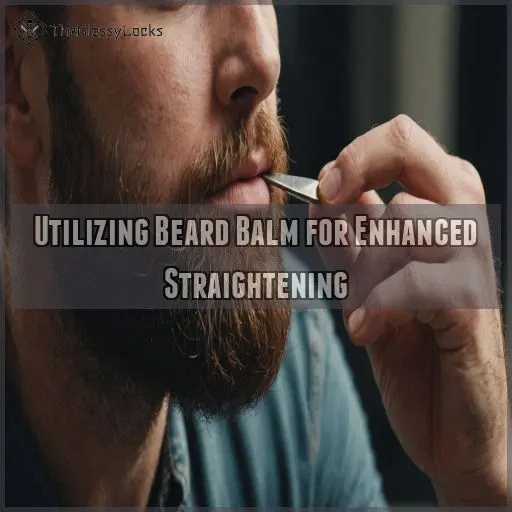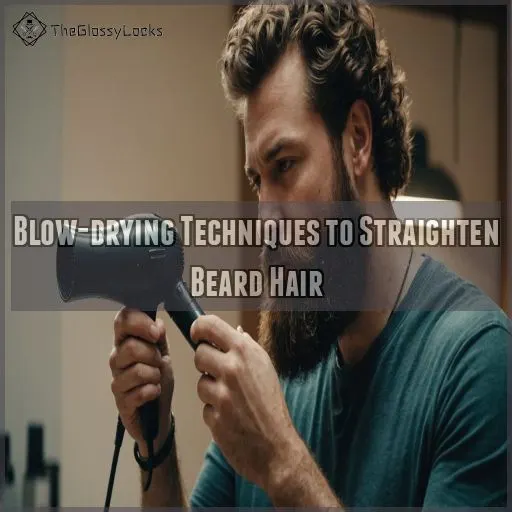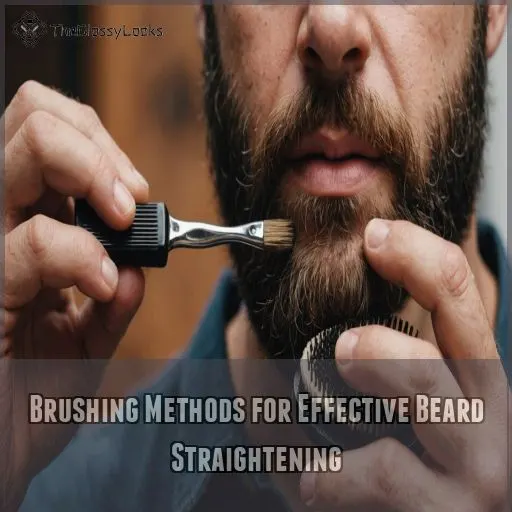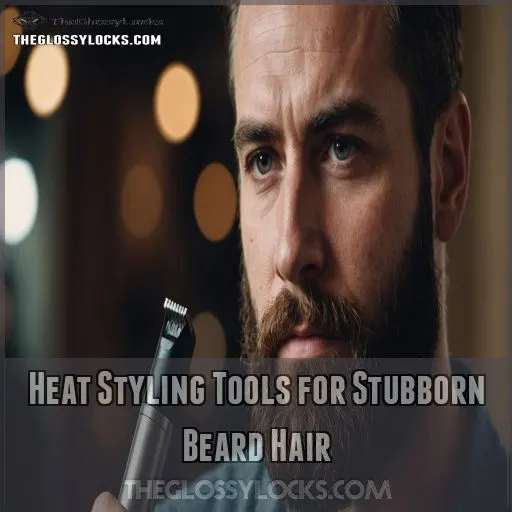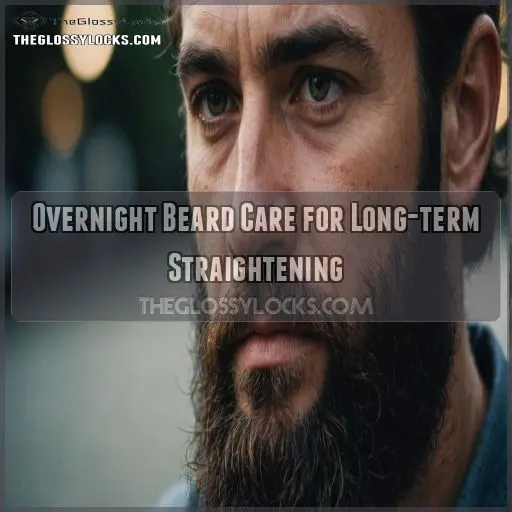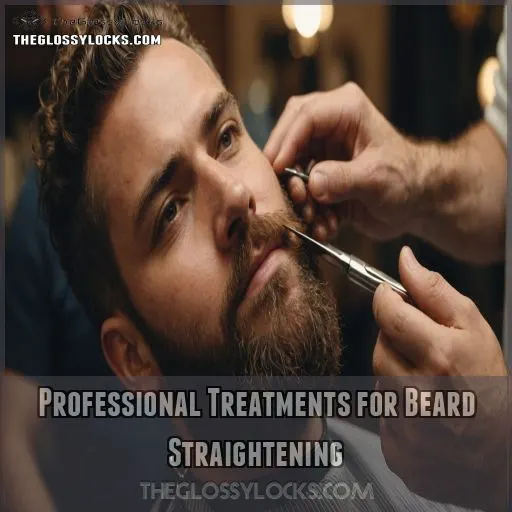This site is supported by our readers. We may earn a commission, at no cost to you, if you purchase through links.
 Straightening your beard can feel like taming a wild beast—but it doesn’t have to be a hairy situation!
Straightening your beard can feel like taming a wild beast—but it doesn’t have to be a hairy situation!
Start with a gentle beard wash, then apply beard oil after showering; it’s like giving your beard a spa day.
Use a dab of beard balm and a blow dryer on a low setting to convince stubborn hairs to fall in line.
A boar bristle brush will be your trusty sword in this battle for sleekness.
Finally, feed your beard the right nutrients; after all, even the best warriors need their protein.
Stay tuned for more tips to transform your mane!
Table Of Contents
- Key Takeaways
- Essential Beard Washing Techniques for Straightening
- Applying Beard Oil to Promote Straightness
- Utilizing Beard Balm for Enhanced Straightening
- Blow-drying Techniques to Straighten Beard Hair
- Brushing Methods for Effective Beard Straightening
- Heat Styling Tools for Stubborn Beard Hair
- Trimming Strategies to Promote Straight Growth
- Overnight Beard Care for Long-term Straightening
- Dietary Considerations for Straighter Beard Growth
- Professional Treatments for Beard Straightening
- Frequently Asked Questions (FAQs)
- How do I make my beard hair straight?
- How do you fix a crooked beard?
- How to make a beard soft and straight?
- How to fix a curly beard?
- How often should I straighten my beard?
- Can humidity affect beard straightening?
- Are there natural ways to straighten a beard?
- What are the risks of straightening too often?
- Does beard straightening impact beard growth?
- Conclusion
Key Takeaways
- Start with the basics by giving your beard a spa-like experience using a gentle beard wash and oil. It’s like a little treat for those whiskers, helping them behave and giving them the flexibility you need.
- Don’t underestimate the power of a good brush and the right tools. A boar bristle brush becomes your trusty sidekick, while a blow dryer on low helps in taming those unruly hairs, working like magic to keep everything in line.
- Remember, your diet plays a role too. It’s like feeding a warrior before battle – proteins, vitamins like biotin, and hydration will keep your beard healthy, strong, and naturally straighter.
- For more dramatic results, you might consider professional treatments or heat styling tools, but proceed with caution. They can be the cavalry charging in, but don’t overuse them, or your beard might end up resembling a battle scar more than a hero’s mane.
Essential Beard Washing Techniques for Straightening
Keeping your beard straight starts with how you wash it—think of it as giving your facial mane a spa day!
With the right wash and techniques, you can keep those wild curls in check, so your beard looks suave and well-groomed without much hassle.
Choosing the Right Beard Wash
Choosing the right beard wash is like picking the perfect partner: it needs to suit you. Go for one with natural ingredients that match your beard type.
Remember:
- Natural Ingredients: Gentle on your beard.
- Scent Preferences: No need to smell like a lavender field unless you want to.
- Beard Type: Coarse, soft, or somewhere in between.
- Price Comparison: Your wallet can thank you later.
Proper Washing Frequency for Straightening
Washing your beard too often can actually dry it out, making it harder to straighten.
Aim for 2-3 washes per week with a gentle, sulfate-free beard wash.
This will cleanse without stripping natural oils that keep your facial hair soft and manageable, a key aspect of beard training.
Adjust frequency based on your beard length and oil production – shorter beards may need more frequent washing.
Water Temperature Considerations
As you master washing frequency, don’t underestimate water temperature’s role in beard grooming. Just like Goldilocks, you’ll want it just right:
- Cold vs. Warm: Warm water opens pores, aiding beard texture.
- Temperature & Growth: Balanced warmth boosts growth.
Soft water is best for a lush rinsing technique.
Too hot can affect your scalp.
Massage Techniques for Effective Cleansing
Your beard’s best friend is a good massage. Gently using your fingertips, work in circular motions. This encourages healthy growth and straightness.
Apply gentle pressure to knock out any tension while dreaming of a straighter beard. Rinse thoroughly afterward.
| Technique | Benefit |
|---|---|
| Circular motions | Enhances growth |
| Gentle pressure | Promotes straightness |
| Fingertip action | Improves cleansing |
Rinsing Methods to Prevent Tangling
When rinsing your beard, aim for lukewarm water.
Hot water can make a curly beard rebellious and prone to tangling.
Finger comb as you rinse to gently detangle.
Consider using a detangling spray or conditioner for an added soft touch.
Avoid vigorous towel drying—pat instead.
Use a blow dryer on low, combined with your bamboo or boar hair brush, to sidestep beard damage.
Applying Beard Oil to Promote Straightness
Applying the right beard oil can work wonders for straightening your unruly [facial hair].
Massage the oil into your beard and skin to nourish the hair, tame flyaways, and promote a smoother, more manageable look.
Selecting Suitable Beard Oils for Straightening
Ready to step up from washing? Grab the right beard oil! Pick oils like jojoba or argan for their sheer magic.
Here are your oil-picking priorities:
- Oil Types: Go for one that matches your beard style.
- Ingredient Focus: Make sure they promise health and shine.
- Oil Consistency: Light for quick absorption.
Treat your beard routine like a trusty sidekick—it’s beardtastic!
Proper Application Techniques for Even Distribution
Applying beard oil correctly is like a gentle dance with your beard.
Start with a few drops and, with delicate brush strokes, massage it through, ensuring each strand gets its fair share.
Think of your fingers as artists, sculpting with oil.
This balm distribution technique sets the groundwork for further product layering, bringing you closer to mastering how to straighten the beard.
Optimal Timing for Oil Application
Now, let’s talk timing. Bet you didn’t think timing matters in beard oil application, did you? For maximum straightness:
- Morning vs. night: Experiment to find what works best.
- Before or after shower: Go after; a clean beard absorbs better.
- Oil type impact: Some oils work better at night.
- Beard length factor: Longer beards might need twice-a-day care.
Pick your perfect timing!
Massaging Methods to Enhance Absorption
Massaging the beard oil into your skin is key for best absorption. Gently rub the oil in using your fingertips, working it from the roots to the ends. This boosts circulation, helping the nourishing ingredients penetrate deep and stimulate healthy hair growth. It’s a simple yet effective way to get the most out of your beard oil.
Circulation is boosted by massaging the beard oil into the skin. This helps the nourishing ingredients penetrate deep and stimulate healthy hair growth.
Product Penetration is enhanced by massaging the beard oil into the skin. This allows the nourishing ingredients to penetrate deep and stimulate healthy hair growth.
Hair Growth is stimulated by massaging the beard oil into the skin for healthy growth. This helps the nourishing ingredients penetrate deep and stimulate healthy hair growth.
| Massage Technique | Circulation Benefits | Product Penetration | Hair Growth Stimulation |
|---|---|---|---|
| Fingertip Rubbing | Increased Blood Flow | Deeper Absorption | Follicle Stimulation |
| Circular Motions | Improved Oxygen Supply | Faster Nutrient Delivery | Stronger, Healthier Hairs |
| Gentle Pressure | Enhanced Skin Hydration | Better Product Utilization | Accelerated Growth Cycle |
| Upward Strokes | Stimulated Sebum Production | Maximized Conditioning | Reduced Breakage/Shedding |
Frequency of Oil Application for Best Results
To achieve that enviable straight beard, apply beard oil 3-4 times a week, depending on beard length and texture.
Think of it as a drink for your beard—hydrating and nourishing.
Choose the right oil type and consistency for your hair texture, ensuring it absorbs well.
Trust me, with regular use, your beard will thank you!
Utilizing Beard Balm for Enhanced Straightening
If your beard’s got a mind of its own, beard balm is your best buddy for taming those wild hairs.
Think of it as a gentle hug for your beard, adding just the right amount of hold to keep everything in line.
Choosing the Right Beard Balm Consistency
When selecting balm consistency for straightening your beard, picture your styling goals.
For lighter hold, go for a softer balm; for stronghold, opt for a firmer consistency.
Remember, your beard type plays a role too – thicker beards often benefit from a sturdier balm.
Think of it as choosing the right tool for the job and embrace the power it gives you!
Proper Application Techniques for Straightening
When applying beard balm for straightening, start by scooping a small amount into your palms and rub them together to warm and soften the balm.
Gently work the balm through your beard, focusing on the areas that need the most taming.
Use a boar bristle brush to evenly distribute the balm from roots to ends, training the hairs into place.
Balm Distribution Methods for Even Coverage
When it comes to beard straightening, your mastery starts with applying balm.
Use fingertips or a brush – whichever you prefer – to make sure the balm is spread evenly.
Don’t be shy about sectioning the beard: it’s like parting the Red Sea, making balm consistency work for you.
Combining Balm With Other Straightening Products
After ensuring even balm coverage, let’s add some reinforcements.
Think of your beard like a superhero team – you need more than just one contender.
Combine balm with:
- Oil: Adds moisture and shine.
- Blow Dryer: Aids in drying and setting the style.
- Brush: Smooths and shapes.
- Wax: Extra hold for rebels.
Your beard’s power squad awaits!
Ideal Timing for Balm Application in Routine
You’ve got your beard balm ready. Apply it right after showering, while your beard’s still slightly damp, for better absorption. It’s like hitting the snooze button—just feels right! Think of it as part of your morning routine.
Need a night ritual? Slap some on before bed, letting those nutrients work their magic overnight and ensuring your beard stays fabulous.
Blow-drying Techniques to Straighten Beard Hair
Blow-drying can be a game-changer for straightening your beard. Master the right heat and speed settings, plus targeted drying techniques, and you’ll have a smooth, sleek look in no time.
Selecting the Right Blow Dryer for Beards
If you want to straighten your beard with a blow dryer, you’ve got to pick the right tool for the job.
Think of these key features:
- Heat Settings: Adjustable options prevent damage.
- Nozzle Types: Concentrate airflow based on beard length.
- Airflow Power: A strong blow dryer means quicker results.
Choose wisely, and your beard will behave like never before!
Proper Heat and Speed Settings
Think of your beard like a prized horse that needs gentle handling.
Blow dryers are your trusty reins.
Use low heat to avoid heat damage; the gentle warmth aligns the hairs without scorching.
Speed matters too—start slow, like a careful driver on icy roads.
Different blow dryer types vary, so choose wisely for a smooth ride.
Directional Drying Techniques for Straightening
Heat and speed settings are key, but the direction you blow-dry your beard is the secret sauce.
Master directional drying with these steps:
- Try angling the blow dryer downwards, following beard growth.
- Comb while drying to guide unruly hairs.
- Keep an eye on drying time to avoid a dry desert look.
- Apply products after for added control.
Using Attachments for Targeted Straightening
Attachments can be game-changers when blow-drying for straightening. Comb nozzles help direct airflow and smooth hair, while round brush attachments lift and straighten.
Experiment with heat settings – lower heat prevents damage. Focus the airflow in the direction you want the hair to lie.
These targeted tools make blow-drying a breeze for straighter results.
Combining Blow-drying With Brushing Techniques
Imagine this: your beard is like a rebellious teenager, and you’re the calm parent guiding it into shape.
Start with the right heat settings, using a blow dryer, and brush types suited for your hair length.
Dry in the opposite direction for volume, then down for straightness.
A consistent maintenance routine is your secret weapon to maintaining that sleek look.
Brushing Methods for Effective Beard Straightening
Brushing your beard might seem like a small step, but with the right techniques, it can turn your unruly whiskers into a masterpiece.
Whether you’re dealing with a wild mane or just a few stray hairs, grabbing the right brush and giving it some consistent attention can make your beard look straighter and more polished with minimal fuss.
Choosing the Right Brush Type for Straightening
Mastering beard straightening isn’t just about blow drying; it’s a game of picking the right brush, too.
Brush bristle types, like boar vs. bamboo, can have a big impact.
Brush size is important to manage your beard’s reach.
Handle ergonomics offer comfort during daily brushing.
Don’t skimp on brushing frequency to train those unruly hairs!
Proper Brushing Techniques for Different Beard Lengths
Whether you have a short stubble or a long, luxurious mane, the right brushing technique is key for straightening your beard.
For shorter beards, brush downward in the direction of growth to train the hairs.
With longer locks, brush from the bottom up to lift and smooth the strands.
Experiment to find what works best for your unique beard.
Frequency of Brushing for Optimal Results
How often should you brush your beard for that sleek, straight look? It depends on beard length and hair texture, of course.
Generally, a daily brushing routine is spot on—keeps it straight, with a brush type that suits you.
Want more power over your beard’s destiny? Go for it daily for desired straightness, and watch those curls surrender!
Combining Brushing With Other Straightening Methods
Head first into brushing and blend it with other methods to tame that beard beast.
Use a blow dryer after applying oil to get smooth results.
What’s the secret sauce? Try these combos:
- Brushing, balm, and heat: Soft as a cloud.
- Brushing, trimming, and growth: Define that edge.
- Brushing, overnight care, and products: Sweet dreams, straight beard.
Training Beard Hair Through Consistent Brushing
Your beard’s like a wild stallion—train it with consistent brushing to tame those unruly curls.
Choose a quality beard brush, like boar bristle, and set a regular brushing schedule.
Brush in the growth direction for the best results, like a maestro guiding an orchestra.
Over time, your beard hair growth will harmonize, and you’ll master the art of a sleek and structured look.
Heat Styling Tools for Stubborn Beard Hair
Dealing with stubborn, unruly beard hair? No need to fret – heat styling tools like curling irons or flat irons can be your secret weapon for achieving a sleek, straight look.
From flat irons to heated brushes, we’ll guide you through selecting the right tools and using them safely to tame even the most rebellious facial fuzz.
Selecting Appropriate Heat Styling Tools
Let’s talk about heat styling tools for beard mastery!
Choose wisely between flat irons and heated brushes.
For hair type and desired style, focus on tool features.
Flat irons provide intense straightening but demand caution; heated brushes offer more control and safety.
Tame that beard like a pro!
Safe Temperature Settings for Beard Hair
When using heat styling tools on your beard, you’re walking a fine line between sleek and scorched.
Temperature guidelines depend on beard hair types, but aim for 250°F-300°F to dodge heat damage.
Different heat tool types can flirt with danger at higher temps.
Proper Technique for Using Flat Irons
Using flat irons on your beard feels like taming a rebellious beast.
Carefully section it into small sections first.
Stick to low heat settings to avoid a scorched mess.
Glide the iron slowly and steadily, like a smooth jazz tune, until straight.
Let it cool down before tackling the next section.
Utilizing Heated Beard Brushes Effectively
Heated beard brushes can be a game-changer for straightening stubborn hairs, but use them with care.
Start on the lowest heat setting and work in small sections, gently brushing downward.
The bristles will help train your beard while the warmth relaxes the strands.
Just don’t overdo it – moderation is key to avoid frying your facial fuzz.
Protecting Beard Hair From Heat Damage
Now you’re holding the heated beard brush, let’s focus on shielding those whiskers.
Apply heat protectant products to form a barrier against styling risks.
Curious about fixing damaged hair?
Opt for low-heat alternatives and give it extra TLC with some cooling techniques.
Be wise and safeguard your beard’s crowning glory.
Trimming Strategies to Promote Straight Growth
Let’s face it, your beard doesn’t always grow the way you want it to.
Tackling the right trimming strategies means saying goodbye to stray hairs and promoting straight growth, so your beard stands tall and proud!
Identifying Areas That Need Trimming
Trimming your beard is like mowing a lawn—get those edges sharp!
Identify problem areas first:
- Neckline: Keep it tidy for a polished look.
- Beard line: Define it to frame your face.
- Split ends and flyaways: Snip these to maintain health and straightness.
- Uneven growth: Even things out for a consistent appearance.
Stay sharp, my friend!
Proper Trimming Techniques for Straightening
Proper trimming techniques are key to straightening your beard. Start by identifying the areas that need attention – focus on taming unruly hairs and creating clean, defined edges. Use sharp, high-quality trimmers to carefully sculpt your beard, following the natural growth pattern. With a light touch, you can gradually shape your facial hair for a sleek, polished look.
Trimming techniques can help you achieve a variety of styles.
| Trimming Technique | Benefits | Considerations |
|---|---|---|
| Fading | Blends edges for a smooth change | Requires practice to achieve a natural fade |
| Precision Edging | Defines the neckline and cheek lines | Take care not to over-trim and create harsh lines |
| Layering | Removes bulk for a lighter, straighter appearance | Adjust layer lengths to suit your beard style |
Frequency of Trimming for Optimal Results
Thinking about how often you should trim? It’s all about balance!
Every beard has its own growth cycle, and your trim frequency depends on its length and texture.
Aim for every two to four weeks to keep things neat and aligned.
Remember, a consistent trim keeps your beard in shape just like a well-pruned garden thrives. Happy trimming!
Tools for Precise Trimming and Shaping
Even the most majestic beards need a little tidy-up. Grab those tools and let’s get to work!
- Beard Trimmer Types: Choose electric for ease or manual for precision.
- Electric vs Manual: What suits your style?
- Shaping Tools: Invest in a quality pair.
- Trimming Techniques: Slow and steady wins the race.
- Beard Line Maintenance: Sharp lines, sharper you.
Maintaining Beard Shape While Straightening
Keeping your beard shape on point while straightening is like holding a tiger by the tail—tricky but rewarding.
Master trimming techniques suited to your beard length, and pair them with top styling products.
Pick a trusty brush to train those whiskers.
Trim regularly—imagine it as maintaining your power over your beard’s look.
Voilà, a stylishly straight masterpiece!
Overnight Beard Care for Long-term Straightening
Achieving long-term beard straightening doesn’t have to be a daily chore.
With the right overnight care routine, you can wake up to a smoother, more manageable beard that stays straight all day long.
Preparing the Beard for Nighttime Care
Now that you’ve trimmed for a neat look, let’s chat nighttime beard care.
Before hitting the hay, apply some beard oil for nourishment.
Your bedtime routine should include brushing your beard gently, choosing a silky pillowcase to keep those strands happy, and maybe even considering a hair wrap to prevent morning chaos.
Your beard will thank you!
Using Leave-in Conditioners for Overnight Straightening
You’ve tucked your beard in for the night, but it needs more than sweet dreams—it needs a leave-in conditioner. This kinder, gentler approach has your back (or chin, rather).
- Choose from various leave-in conditioner types.
- Incorporate this into your overnight routine.
- Use the best products for great results.
- Wake up to morning results that make you smile.
Selecting Appropriate Pillowcases for Beard Care
A good night’s sleep can do wonders for your beard.
Satin pillowcases are like a spa treatment for your beard! They reduce friction, so your beard stays straighter and healthier. It’s like giving your beard a hug every night!
Ditch that old cotton pillowcase, which may feel like sandpaper against your beard, creating friction and split ends.
Morning Routines to Enhance Overnight Results
Start your day right by giving your beard a quick touch-up.
Spritz on a light beard mist to rehydrate and revive those overnight-straightened hairs.
Run a boar bristle brush through your beard, following the grain, to redistribute any styling products and smooth flyaways.
This quick morning routine will help maintain your beard’s sleek, straight look all day long.
Dietary Considerations for Straighter Beard Growth
Your diet’s got more to do with your beard’s straightness than you might think, so don’t skip the veggies next time!
Eating the right nutrients and staying hydrated can help transform your beard from wild to wonderfully straight,
saving you some wrestling with the flat iron.
Diet and hydration can improve beard straightness.
Eating the right foods and staying hydrated can transform your beard from wild to straight.
Nutrients That Promote Straighter Hair Growth
As you prepare your beard for the night, think about what’s on your plate.
Embrace hair growth vitamins like biotin to support straighter strands.
Picture protein as your beard’s best friend, partnering with healthy fats for a smooth result.
It’s not just grooming; it’s fueling your beard from the inside out, just like Arnold Schwarzenegger does.
Hydration’s Role in Beard Straightening
While nutrients play their part, grabbing that water bottle’s your next step!
Hydration impacts beard straightening—think of it as giving your beard’s roots a spa day.
Proper water intake and healthy oils help your beard’s about as straight as your morning coffee.
Quench that thirst, and your beard’ll have the gloss and poise of a gentleman off to a gala!
Supplements for Improving Beard Texture
Supplements like biotin, collagen, and zinc can work wonders for improving the texture and straightness of your beard.
Vitamin E and omega-3s also nourish hair follicles for healthier, more manageable growth.
Try incorporating these supplements into your routine and see the difference in your beard’s softness and manageability.
Foods to Avoid for Straighter Beard Hair
To keep your beard as straight as an arrow, steer clear of these culinary culprits:
- Sugar: Sneaky beard bender, making hairs frizz and stray.
- Dairy: It’s not just for goats; it might curl your beard too!
- Processed Foods: They twist your taste buds—and your beard hairs!
- Alcohol: Not just a liver lollipop, it dehydrates, leaving your beard all tangled.
Meal Planning for Optimal Beard Health
Planning meals for good beard health is key to wielding a beard that commands respect.
Eat foods rich in vitamins and nutrients.
Combine protein-packed foods with leafy greens for beard growth and texture.
Timing meals right can boost nutrient absorption, while supplements fill gaps.
Keep meal frequency in check to maintain energy and support beard mastery!
Professional Treatments for Beard Straightening
When taming your stubbornly curly beard feels like wrestling a wild animal, professional treatments can offer the extra help you need.
From chemical straightening to keratin treatments, embracing these specialized options might just transform your beard from unruly to irresistible.
Salon Treatments for Stubborn Curly Beards
If your beard’s stubbornly curly, don’t worry – professional salon treatments can work wonders.
The experts can assess your hair type and recommend the right approach, whether that’s keratin treatments to smooth and strengthen, or specialized chemical straightening for a more dramatic transformation.
Just be sure to follow their guidance for maintaining the results at home.
Chemical Straightening Options and Risks
Chemical straightening options for your beard can tame those wild curls.
However, be aware of risks like long-term hair damage and unwanted side effects.
It’s no cakewalk managing potential breakage.
Consider alternatives and preventive measures to keep your beard healthy.
सावधान रहें!
Keep your tools sharp and choices sharper.
Keratin Treatments for Beard Hair
Thinking about taming that wild beard with keratin treatments? They’re like giving your beard a spa day! Keratin treatment benefits include smooth, straight hairs, but beware of risks like dryness. They can cost a pretty penny and last a few months.
Prefer alternatives? Consider natural methods or heat styling tools.
Explore options, and choose what suits you best!
Consultation With Beard Care Specialists
For bombproof beard straightening, consult a beard care specialist.
These pros can offer personalized beard care routines, product recommendations, and styling advice with the finesse of a sculptor chiseling marble.
They’ll tackle beard health concerns and growth issues with the precision of a maestro conducting an orchestra.
Don’t let a scruffy beard cramp your style—get expert insights for a dapper finish!
Maintaining Professionally Straightened Beards at Home
After getting your beard professionally straightened, maintaining the results at home is key. Start by using the recommended beard care products – oils, balms, and brushes – to keep your hair smooth and manageable.
Avoid heat styling tools, and instead focus on:
- Gentle daily brushing
- Applying leave-in conditioners overnight
- Trimming stray hairs to preserve your beard’s shape
- Eating a beard-healthy diet
With the right home care routine, you can keep your professionally straightened beard looking its best.
Frequently Asked Questions (FAQs)
How do I make my beard hair straight?
Use beard oil and a boar bristle brush to smooth the unruly hairs.
Try a blow dryer on low heat for added help, but steer clear of flat irons!
How do you fix a crooked beard?
You can fix a crooked beard by using the right grooming tools and techniques.
Start with a high-quality beard brush, then apply beard oil and balm to tame unruly hairs.
Finish by carefully trimming stray strands for a polished, symmetrical look.
How to make a beard soft and straight?
Imagine waking up with your beard magically soft and straight.
Start with a natural beard wash and beard oil.
Brush using a boar bristle brush.
Embrace this routine, and your beard will feel smoother than velvet.
How to fix a curly beard?
Tame unruly curls by applying beard oil and beard butter to keep the hairs soft and manageable.
Use a boar bristle brush to style.
If necessary, gently blow-dry on low heat while combing downward.
How often should I straighten my beard?
Straightening a beard daily can be part of your routine, but adapt based on your beard’s needs.
If you notice dryness or split ends, ease up.
Let the beard breathe—it shouldn’t be a daily battle!
Can humidity affect beard straightening?
Humidity can wreak havoc on your carefully straightened beard.
Think of it like trying to tame a wild mane – the moisture in the air makes those stubborn hairs rebel.
Stay vigilant, my friend, and your beard will stay sleek and smooth.
Are there natural ways to straighten a beard?
You can naturally straighten your beard using beard butter or oils.
They relax curly hairs.
Then, brush with a boar bristle brush.
It’s like training a rebellious toddler—patience and routine work wonders!
What are the risks of straightening too often?
Like a diligent gardener, excessive beard straightening can rob your beard’s natural health, causing dryness, split ends, and breakage.
Keep it in check to maintain a full, lush mane and avoid turning it into straw.
Does beard straightening impact beard growth?
Straightening your beard doesn’t directly impact growth.
Overdoing it, however, can lead to dryness and breakage.
This is similar to trying to tame a wild mane without care.
Keep it hydrated and maintain gentle techniques for best results.
Conclusion
Taming your unruly beard is no small feat, but with these great straightening methods, you’ll be the envy of every well-groomed gent.
From essential washing techniques to heat styling wizardry, this detailed guide has you covered.
Embrace your inner lumberjack and transform your mane into a sleek, stylish masterpiece.
With a little elbow grease and these foolproof how to straighten the beard tips, you’ll be strutting around with a beard that’s as smooth as a baby’s bottom.



